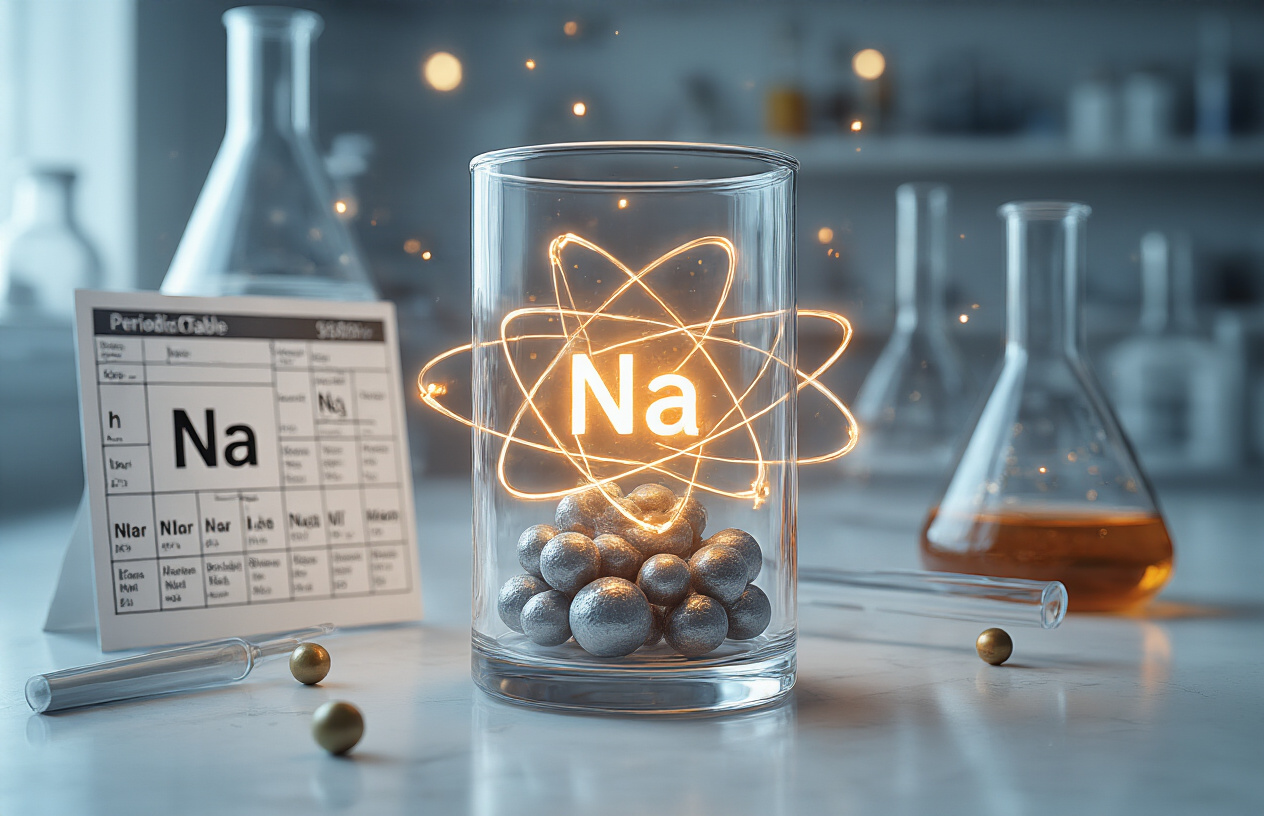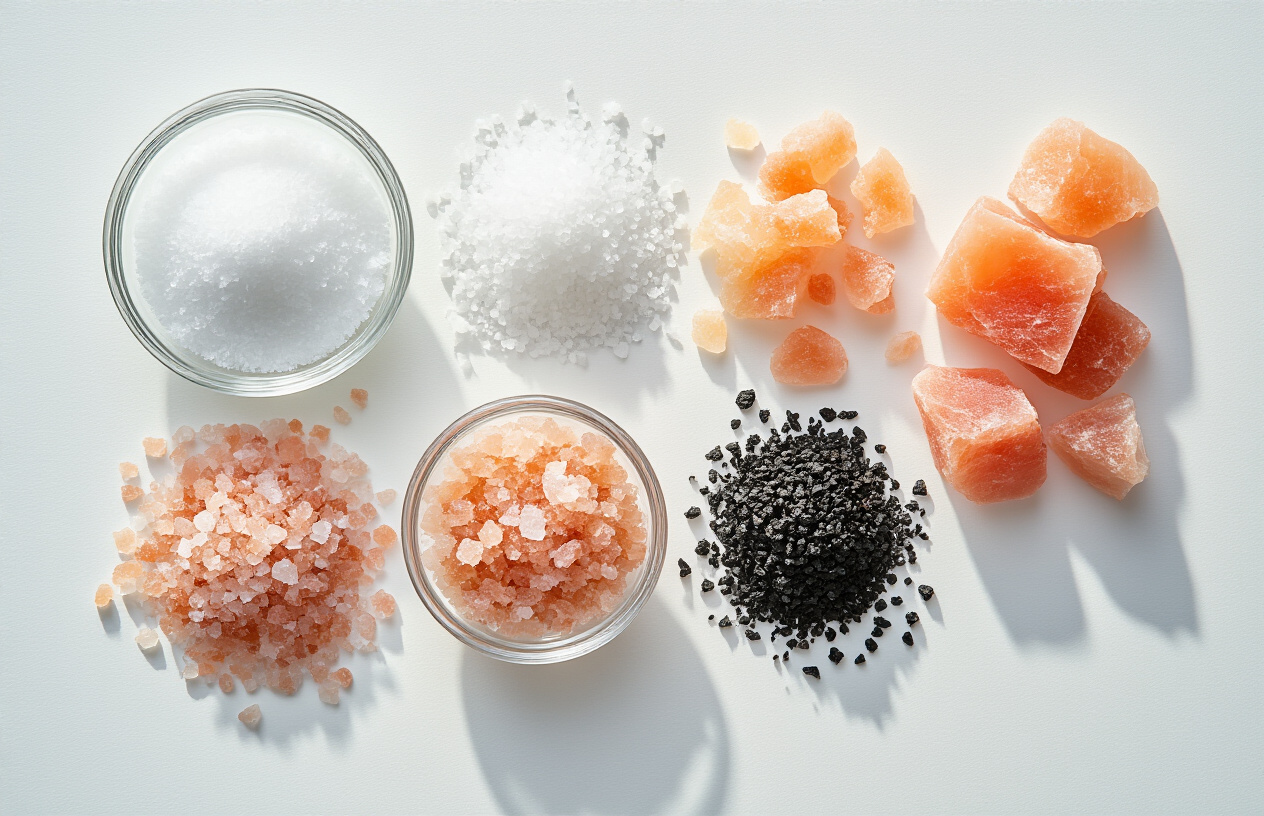Many people use sodium and salt interchangeably, but they’re actually two different things with distinct impacts on your health. This guide is for anyone who wants to understand what they’re really eating and make better food choices.
We’ll break down sodium as a chemical element and explain what salt actually contains. You’ll learn the key nutritional differences between these two and discover how each one affects your body differently. By the end, you’ll know exactly how to read labels and make smarter decisions about the sodium and salt in your diet.
Understanding Sodium as a Chemical Element

Essential Mineral Your Body Needs for Vital Functions
Sodium stands as one of the most critical minerals your body requires to function properly. This silvery-white alkali metal, represented by the symbol Na on the periodic table, plays numerous roles that keep you alive and healthy every single day.
Your body treats sodium like a VIP guest – it carefully controls how much enters and exits your system through sophisticated regulatory mechanisms. Without adequate sodium levels, your body would struggle to maintain the delicate balance needed for cellular communication, blood pressure regulation, and proper organ function.
The human body contains roughly 100 grams of sodium at any given time, with about 40% found in your bones, 50% in the fluid surrounding your cells, and 10% inside your cells. This distribution isn’t random – your body strategically places sodium where it’s needed most for optimal performance.
Role in Nerve Transmission and Muscle Contractions
Sodium acts like your body’s electrical conductor, making it possible for your nervous system to send messages throughout your body at lightning speed. When a nerve cell needs to transmit a signal, sodium ions rush across the cell membrane, creating an electrical charge that travels down the nerve fiber.
This process, called depolarization, happens thousands of times per second in your body. Without sodium, your brain couldn’t tell your heart to beat, your muscles to contract, or your eyes to blink. Every thought you think and every movement you make depends on sodium’s ability to generate these electrical impulses.
Your muscles rely heavily on sodium for proper contraction and relaxation. When sodium levels drop too low, you might experience muscle cramps, weakness, or even dangerous heart rhythm irregularities. Athletes who sweat heavily during intense exercise often need to replenish sodium to prevent these complications.
How Sodium Regulates Fluid Balance in Cells
Think of sodium as your body’s water manager. It works alongside potassium to control how much fluid stays inside your cells versus how much remains in the spaces between cells. This balancing act keeps your cells from swelling up like water balloons or shriveling up like raisins.
Sodium creates what scientists call osmotic pressure – essentially pulling water toward areas where sodium concentrations are higher. Your kidneys use this property to fine-tune your body’s fluid levels, retaining water when you’re dehydrated and releasing excess fluid when you’ve had too much to drink.
This regulation system becomes especially important during illness, exercise, or hot weather when your fluid needs change rapidly. Your body adjusts sodium retention to maintain stable blood volume and prevent dangerous drops in blood pressure.
Daily Sodium Requirements for Optimal Health
Most healthy adults need between 1,500 to 2,300 milligrams of sodium daily for optimal function. The American Heart Association recommends staying closer to 1,500 mg, while the FDA suggests 2,300 mg as an upper limit for most people.
Your individual needs may vary based on several factors:
- Age and activity level: Active individuals and older adults may need slightly more
- Climate conditions: Hot, humid environments increase sodium needs through sweat loss
- Health conditions: Certain medications and medical conditions affect sodium requirements
- Pregnancy and breastfeeding: These states typically increase sodium needs
People with kidney disease, heart failure, or high blood pressure often need to restrict sodium intake to levels below these general recommendations. Always consult your healthcare provider for personalized guidance on your sodium needs.
Defining Salt and Its Common Forms

Table salt as sodium chloride compound
Table salt is essentially sodium chloride (NaCl), a chemical compound made up of sodium and chlorine atoms bonded together in a 1:1 ratio. This white crystalline substance forms when sodium, a highly reactive metal, combines with chlorine gas. The resulting compound is remarkably stable and safe for consumption, despite both parent elements being dangerous on their own.
Commercially produced table salt typically contains about 40% sodium and 60% chlorine by weight. Manufacturers often add anti-caking agents like calcium silicate or sodium ferrocyanide to prevent clumping, plus iodine for nutritional fortification. This iodization process became standard in many countries during the 1920s to combat iodine deficiency disorders.
The crystalline structure of sodium chloride creates those familiar cube-shaped crystals we recognize. Each sodium ion is surrounded by six chloride ions, and vice versa, forming a highly organized lattice structure that gives salt its characteristic properties.
Sea salt and rock salt variations
Sea salt comes from evaporating seawater, leaving behind the dissolved minerals. Unlike refined table salt, sea salt retains trace amounts of other minerals like magnesium, calcium, and potassium, which can subtly affect its flavor and color. These minerals typically make up less than 5% of sea salt’s composition, but they contribute to its slightly more complex taste profile.
Rock salt, also called halite, forms from ancient dried-up seas and salt lakes. Mining operations extract these underground deposits, which can be incredibly pure or contain various mineral impurities depending on their geological history. Himalayan pink salt, for example, gets its color from iron oxide traces.
Different harvesting methods create distinct textures and flavors:
- Flaky sea salts (like Maldon) have large, pyramid-shaped crystals
- Fine sea salts dissolve quickly and distribute evenly
- Coarse rock salts work well for curing and preserving
- Flavored salts incorporate herbs, spices, or smoke during processing
How processing affects salt composition
Processing dramatically changes salt’s final composition and characteristics. Refined table salt undergoes extensive purification that removes virtually all trace minerals, creating nearly pure sodium chloride. This process involves dissolving raw salt in water, filtering out impurities, and re-crystallizing under controlled conditions.
The refining process also eliminates naturally occurring moisture, which is why refined salt flows so freely. Unrefined salts often retain some moisture content, making them slightly sticky or prone to clumping in humid conditions.
Processing methods create different crystal sizes and shapes, affecting how salt dissolves and tastes. Fine table salt dissolves almost instantly on the tongue, delivering a sharp, immediate saltiness. Coarser salts dissolve more slowly, creating a different sensory experience with bursts of flavor.
Some processing methods preserve beneficial minerals while others strip them away entirely. Unrefined sea salts maintain their mineral content, while highly processed varieties lose these compounds. The choice between processed and unprocessed salt often comes down to intended use, flavor preference, and nutritional considerations.
Key Chemical and Nutritional Differences

Sodium Content Percentages in Different Salt Types
Table salt sits at about 40% sodium by weight, meaning that teaspoon of salt you’re sprinkling on your fries delivers roughly 2,300mg of sodium. But here’s where things get interesting – different salt types carry varying sodium concentrations.
| Salt Type | Sodium Content | Key Characteristics |
|---|---|---|
| Table Salt | 40% | Highly refined, often iodized |
| Sea Salt | 38-39% | Less processing, larger crystals |
| Himalayan Pink | 36-38% | Contains trace minerals |
| Kosher Salt | 38-40% | Flakier texture, no additives |
| Celtic Sea Salt | 33-35% | Moisture retained, mineral-rich |
The differences might seem small, but they add up. Celtic sea salt actually contains less sodium per gram than table salt because it retains natural moisture and minerals that displace some sodium content.
Additional Minerals Found in Unprocessed Salts
Unprocessed salts bring a whole mineral party to your plate. While table salt gets stripped down to pure sodium chloride, natural salts keep their original mineral companions.
Himalayan pink salt contains over 80 trace minerals, including:
- Magnesium (supports muscle and nerve function)
- Potassium (helps regulate blood pressure)
- Calcium (bone health)
- Iron (gives it that pink color)
- Zinc (immune system support)
Sea salt captures whatever minerals were floating in its source waters – typically magnesium, calcium, and potassium. Celtic sea salt goes further, containing sulfur compounds and trace amounts of iodine naturally.
These minerals don’t just sit there looking pretty. They can influence taste (that’s why sea salt tastes different from table salt) and may provide small nutritional benefits, though you’d need to eat unrealistic amounts to meet daily mineral requirements through salt alone.
How Your Body Processes Sodium Versus Salt Compounds
Your digestive system treats pure sodium and salt compounds very differently. When you consume table salt (sodium chloride), your stomach acid breaks the ionic bond, releasing both sodium and chloride ions. Your small intestine then absorbs these separately.
Pure sodium – like what you might find in processed foods as sodium benzoate or monosodium glutamate – gets absorbed directly without needing that breakdown step. This can lead to faster sodium spikes in your bloodstream.
Salt compounds with other minerals create a more complex absorption process. The presence of magnesium and potassium in natural salts can actually slow sodium absorption and help your kidneys manage sodium levels more effectively. Your body also uses these companion minerals to maintain proper electrolyte balance.
Bioavailability Differences Between Sodium Sources
Not all sodium hits your system the same way. Bioavailability – how much your body actually absorbs and uses – varies significantly between sodium sources.
Refined table salt gets absorbed quickly and completely, creating rapid sodium spikes. Natural salts with their mineral matrix get absorbed more slowly, leading to gentler increases in blood sodium levels.
Sodium from whole foods (like celery or spinach) comes packaged with fiber, water, and other nutrients that further slow absorption. Your body processes this “food-matrix sodium” more gradually than isolated sodium compounds.
Hidden sodium in processed foods often comes as multiple sodium compounds – sodium phosphate, sodium citrate, sodium nitrite. Each has different absorption rates and biological effects. Some preserve food, others enhance flavor, but all contribute to your daily sodium load in unique ways.
The crystal size of salt also matters. Finer salts dissolve faster on your tongue and in your stomach, potentially leading to quicker absorption than coarser salts that take more time to break down.
Health Impact Comparison Between Sodium and Salt

Blood pressure effects of excess sodium intake
When you consume too much sodium, your body holds onto extra water to dilute the sodium concentration in your blood. This extra fluid puts additional pressure on your blood vessel walls, leading to higher blood pressure. Your kidneys, which normally filter excess sodium from your body, can become overwhelmed when sodium intake is consistently high.
The American Heart Association recommends no more than 2,300 milligrams of sodium per day, with an ideal limit of 1,500 milligrams for most adults. However, the average American consumes about 3,400 milligrams daily. This excess sodium intake directly correlates with increased risks of:
- Hypertension (high blood pressure)
- Heart disease and stroke
- Kidney damage and kidney stones
- Fluid retention and swelling
Your blood pressure typically responds to sodium reduction within days or weeks. Studies show that cutting sodium intake by just 1,000 milligrams per day can lower systolic blood pressure by 5-6 mmHg in people with hypertension.
Benefits of choosing less processed salt options
Different types of salt contain varying amounts of sodium and additional minerals that can impact your health differently. Here’s how various salt options compare:
| Salt Type | Sodium Content | Key Benefits |
|---|---|---|
| Table Salt | 40% sodium | Iodine fortification |
| Sea Salt | 38-39% sodium | Trace minerals, less processing |
| Himalayan Pink Salt | 36-38% sodium | Natural minerals, no additives |
| Celtic Salt | 33-35% sodium | Higher mineral content, less sodium |
Less processed salts often contain beneficial minerals like potassium, magnesium, and calcium. These minerals can help counteract some of sodium’s negative effects on blood pressure. Potassium, in particular, helps your kidneys flush out excess sodium and relaxes blood vessel walls.
Sea salt and rock salts also tend to have larger crystals, which means you might use less overall while still getting satisfying flavor. The coarser texture provides more immediate taste impact, allowing you to achieve the same flavor satisfaction with smaller quantities.
Hidden sodium sources versus visible salt consumption
Most people focus on the salt shaker when trying to reduce sodium, but visible salt only accounts for about 11% of total sodium intake. The real culprits hide in processed and restaurant foods where you can’t see or control the amount.
Major hidden sodium sources include:
- Processed meats (bacon, deli meats, sausages): 400-1,200mg per serving
- Canned soups: 600-1,300mg per cup
- Restaurant meals: Often 2,000-4,000mg per entrée
- Bread and baked goods: 100-400mg per slice
- Cheese: 150-500mg per ounce
- Condiments and sauces: 100-800mg per tablespoon
Visible salt consumption happens when you add salt during cooking or at the table. This gives you direct control over sodium intake and typically contributes much less to your daily total than hidden sources.
Reading nutrition labels becomes crucial since sodium content varies dramatically between brands. A single frozen dinner can contain an entire day’s worth of recommended sodium, while the same meal prepared at home with fresh ingredients might contain less than 400 milligrams.
Restaurant meals pose the biggest challenge because sodium content isn’t always disclosed. Chain restaurants now provide nutrition information, but independent restaurants rarely do. When dining out, ask for dressings and sauces on the side, choose grilled over breaded items, and request that your meal be prepared with less salt.
Making Smarter Dietary Choices

Reading Nutrition Labels for Sodium Content
Most people glance at calories and move on, but the sodium content listed on nutrition labels deserves your attention. The number you see represents milligrams of sodium per serving, not salt. This distinction matters because sodium makes up only about 40% of table salt’s weight. When a label shows 400mg of sodium, you’re actually consuming about 1,000mg (1 gram) of salt.
Pay attention to serving sizes – they’re often smaller than what people actually eat. A can of soup might list two servings, so double those sodium numbers for the full can. Look for terms like “reduced sodium” (25% less), “low sodium” (140mg or less per serving), and “no salt added” (though natural sodium may still be present).
The daily value percentage helps put things in perspective. The FDA recommends staying under 2,300mg of sodium daily, with 1,500mg being ideal for most adults. If one serving gives you 20% of your daily value, you’re looking at a high-sodium food.
Reducing Sodium Intake Without Sacrificing Flavor
Cutting sodium doesn’t mean bland food. Fresh herbs like basil, cilantro, and rosemary pack serious flavor punch without any sodium. Garlic, onions, and ginger create savory depth that makes you forget about missing salt.
Acid brightens dishes naturally – try lemon juice, lime juice, or different vinegars. A splash of balsamic vinegar or apple cider vinegar can transform vegetables and proteins. Spices like cumin, paprika, and black pepper add complexity without sodium.
Cook from scratch when possible. Restaurant meals and processed foods contain hidden sodium that home cooking eliminates. When you do use salt, add it at the end of cooking – you’ll taste it more and need less.
Gradual reduction works better than going cold turkey. Your taste buds adapt over about two weeks, so slowly decrease sodium while increasing other flavors.
Best Salt Alternatives for Health-Conscious Consumers
Potassium chloride salt substitutes like NoSalt and Morton Salt Substitute provide the salty taste with beneficial potassium instead of sodium. Start with small amounts – they can taste slightly bitter or metallic at first.
Herb and spice blends offer complex flavors without sodium. Mrs. Dash, Trader Joe’s 21 Seasoning Salute, and homemade mixtures of dried herbs work well. Make your own by combining garlic powder, onion powder, dried oregano, and black pepper.
Nutritional yeast gives foods a savory, almost cheesy flavor that’s particularly good on popcorn and pasta. Seaweed flakes provide natural saltiness plus minerals.
Citric acid (found in citrus fruits) enhances flavors similarly to salt. You can buy it in powder form to sprinkle on foods.
Balancing Sodium Needs with Cardiovascular Health
Your body needs some sodium for nerve function, muscle contractions, and fluid balance – about 500mg daily. Most Americans consume five times that amount, putting strain on the cardiovascular system.
High sodium intake forces your heart to work harder by increasing blood volume and pressure against artery walls. People with existing heart conditions, diabetes, or kidney disease need stricter limits, often 1,500mg or less daily.
Athletes and people who sweat heavily may need slightly more sodium, but whole foods and a normal diet usually provide enough. Sports drinks are rarely necessary for casual exercisers.
Work with your doctor to find your ideal sodium intake. Blood pressure medications, kidney function, and other health factors influence your personal needs.
When to Choose Specialty Salts Over Regular Table Salt
Specialty salts aren’t necessarily healthier sodium-wise, but they can enhance cooking in specific ways. Sea salt and Himalayan pink salt contain trace minerals that regular table salt lacks, though not in nutritionally significant amounts.
Finishing salts like flaky sea salt work well sprinkled on dishes just before serving. Their larger crystals provide bursts of flavor that let you use less overall. Kosher salt’s larger grains make it easier to control portions when cooking.
Smoked salts add flavor complexity without extra sodium. A pinch goes far in enhancing grilled meats or roasted vegetables.
Save specialty salts for dishes where you’ll actually taste the difference. Using expensive sea salt in pasta water wastes both money and the salt’s unique characteristics. Regular table salt works fine for cooking water and baking, while finishing salts shine when used sparingly as final touches.

Sodium and salt aren’t the same thing, even though we often use these terms interchangeably. Sodium is a chemical element that’s part of salt, but salt contains other components too. When you’re reading nutrition labels, you’re mainly concerned with sodium content since that’s what affects your blood pressure and heart health. Different types of salt contain varying amounts of sodium, so understanding this difference helps you make better choices for your body.
The bottom line is simple: watch your sodium intake, not just your salt intake. You can still enjoy flavorful meals by choosing lower-sodium alternatives, experimenting with herbs and spices, and reading food labels carefully. Your heart will thank you for paying attention to these small but important distinctions in your daily eating habits.













